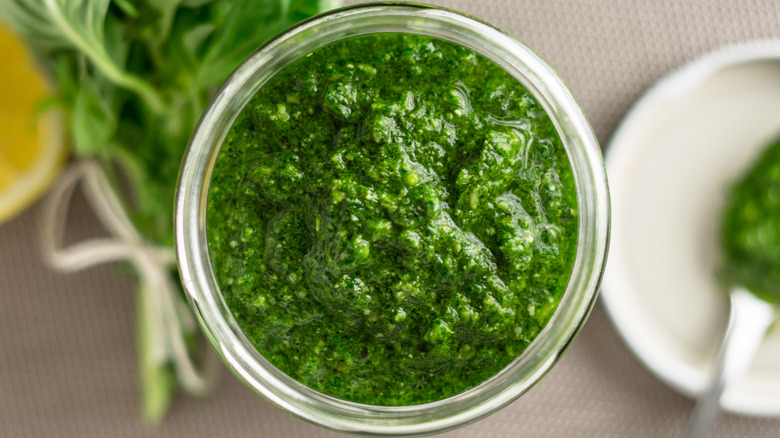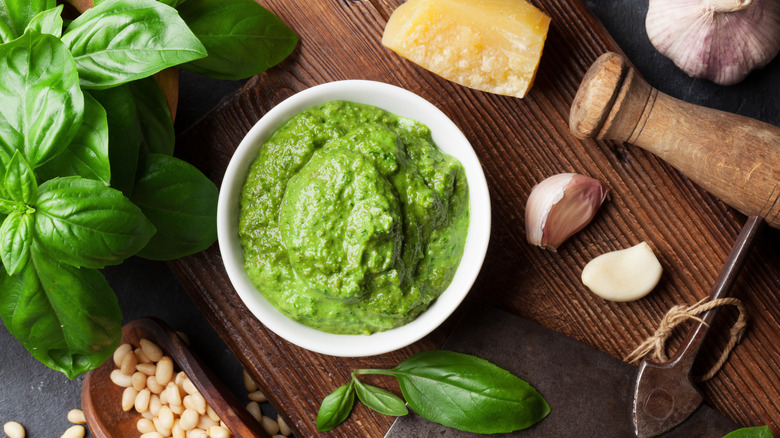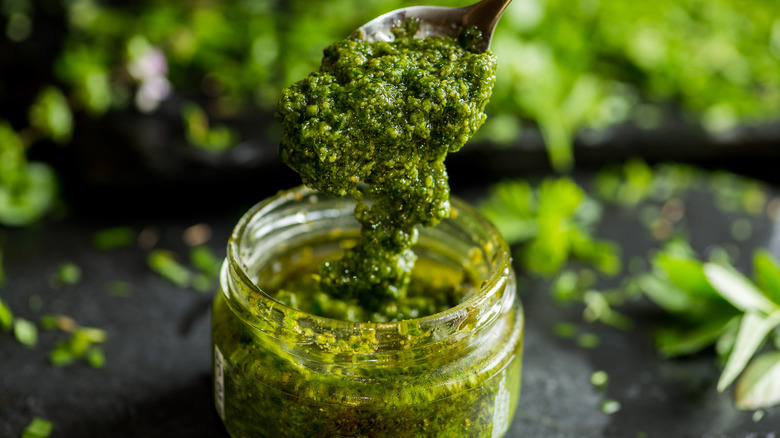Blanch Your Herbs To Keep Homemade Pesto From Turning Brown
Whether you are making a basic basil pesto to serve on linguine for family pasta night, or branching out to try your hand at something more unique such as sage and arugula pesto, there is nothing quite like that garden-fresh aroma and bright green color. That is, until it turns brown, quickly transforming one of life's simple pleasures into a muddy, unappetizing mess. Enzymes in the herbs are to blame, and you can easily short-circuit them in under a minute by blanching the herbs before making your pesto.
Oxidation can ruin the appearance and appeal of a wide variety of foods, including pesto. It also occurs quickly, often in as little as an hour. Some cooks will try to combat this problem by using lemon juice (a natural antioxidant), particularly on the cut ends of produce, such as apples, to keep them looking fresh. While this can help somewhat with pesto, it is not the best option because it will alter the flavor of your sauce. A better solution here is to blanch your basil or other herbs before creating your pesto.
How to blanch your pesto herbs
If you've ever stored excess garden vegetables away in your freezer for use during the long winter months, you are probably familiar with blanching. The process is very quick and easy. Start by bringing a pot of water to a boil. You shouldn't need much water — just enough so that it will completely cover the herbs when you add them to the pot. Once the water is boiling, toss in the herbs for a quick blanch; a few seconds should do the trick. Carefully remove the herbs and plunge them into a ready ice bath to shock them and completely stop the cooking process. Once cool, dry the herbs completely before using them in your pesto recipe to make sure things don't get watery.
Blanching will not only help kill bacteria that can make foods unsafe to eat, but it will also deactivate those enzymes present that will degrade the vibrancy of your basil. Note that over-blanching (aka boiling) can leech away vital elements such as vitamins, starches, and sugars from food. As such, you should take care not to blanch your basil for too long.
How long will my lovely green pesto be good for?
While blanching provides a number of benefits to foods such as pesto, it will not magically make your sauce last forever — it is not an all-in-one food preservative. Fresh pesto should be refrigerated as soon as it is made. In the refrigerator, pesto will be good for at least three days – although it will usually retain its quality and taste for up to a week.
You can help to extend the life of your pesto by making sure that it is stored in a sealed, airtight container. Adding a layer of olive oil atop the pesto can also help to maintain its appearance and taste. If you are not planning on using the pesto right away, consider freezing it. Ice cube trays work great for this, providing you with single-serving sizes of bright green pesto that will last up to six months in the freezer.
How do you know if your pesto has gone bad? If it has been sitting in the refrigerator for several days, you can run the usual quality tests on it. Does it smell bad? Is it moldy? Is the taste and texture acceptable? If the pesto seems suspect, toss it and create a fresh batch.



